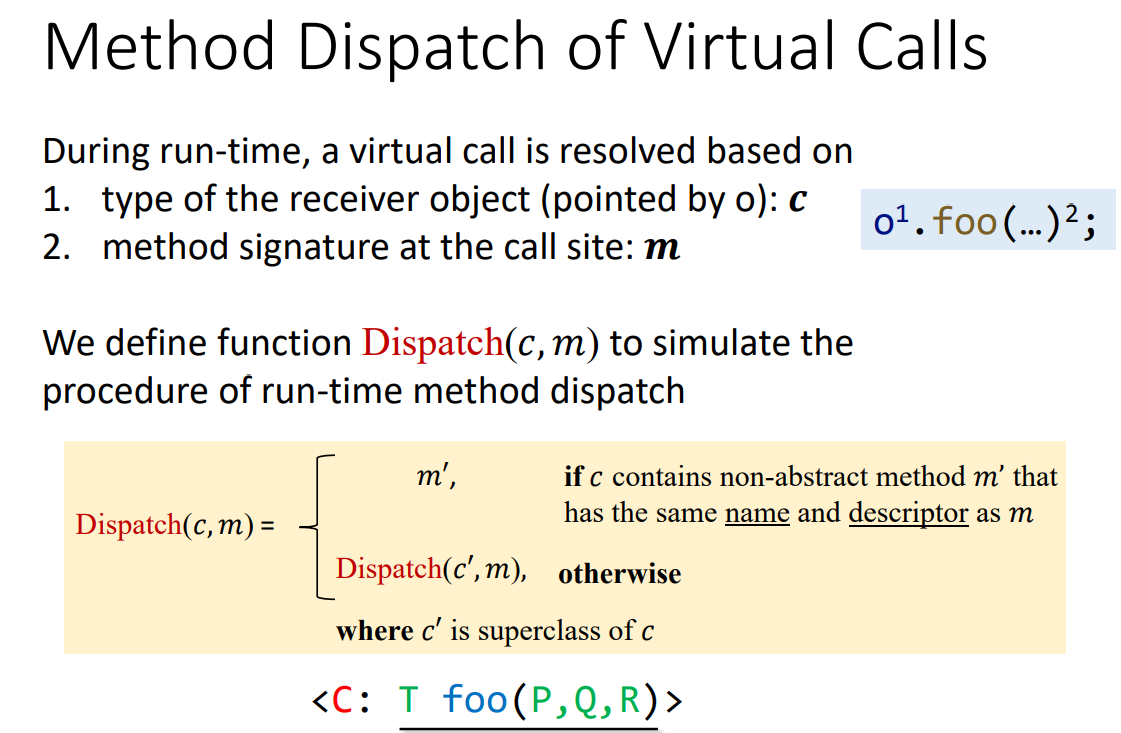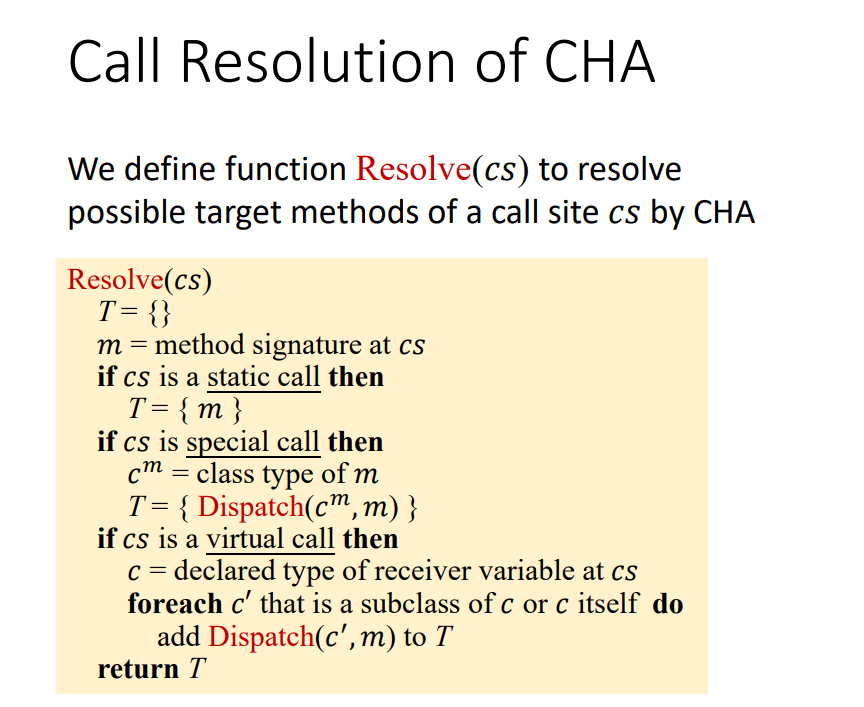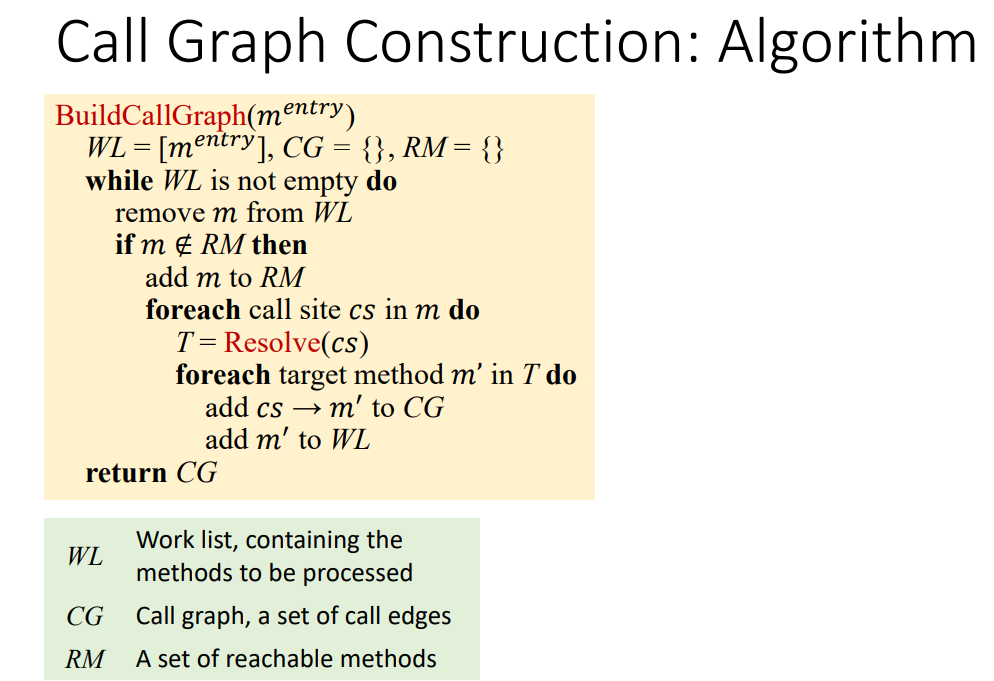【南大静态代码分析】作业 4:类层次结构分析与过程间常量传播
作业 4:类层次结构分析与过程间常量传播
实现类层次结构分析(CHA)
dispatch:根据方法调用者的类和方法签名寻找目标方法。

比较显然,是个递归算法。
递归的终止条件有两个,一个是如果一直找不到相应方法,不断递归到父类,最后递归到 Object 在向上递归就是 null ,Object 没有父类,此时返回空,说明找不到相应方法;另一个是如果当前类的方法中有能匹配方法签名的方法,并且该方法不是抽象方法,说明找到相应方法,返回该方法。
其他情况向当前类的父类递归。
/**
* Looks up the target method based on given class and method subsignature.
*
* @return the dispatched target method, or null if no satisfying method
* can be found.
*/
private JMethod dispatch(JClass jclass, Subsignature subsignature) {
// TODO - finish me
if (jclass == null) {
return null;
}
if (jclass.getDeclaredMethod(subsignature) != null && !jclass.getDeclaredMethod(subsignature).isAbstract()) {
return jclass.getDeclaredMethod(subsignature);
}
return dispatch(jclass.getSuperClass(), subsignature);
}
resolve:通过类的继承关系确定一个调用点的所有可能的目标方法。

/**
* Resolves call targets (callees) of a call site via CHA.
*/
private Set<JMethod> resolve(Invoke callSite) {
// TODO - finish me
Set<JMethod> T = new HashSet<JMethod>();
MethodRef m = callSite.getMethodRef();
Subsignature subsignature = m.getSubsignature();
JClass declaringClass = m.getDeclaringClass();
CallKind callKind = CallGraphs.getCallKind(callSite);
switch (callKind) {
case STATIC -> {
T.add(declaringClass.getDeclaredMethod(subsignature));
break;
}
case SPECIAL -> {
T.add(dispatch(declaringClass, subsignature));
break;
}
case VIRTUAL, INTERFACE -> {
ArrayDeque<JClass> subclasses = new ArrayDeque<>();
HashSet<JClass> set = new HashSet<>();
subclasses.addLast(declaringClass);
set.add(declaringClass);
while (!subclasses.isEmpty()) {
JClass subclass = subclasses.pollFirst();
T.add(dispatch(subclass, subsignature));
for (JClass jClass : (hierarchy.getDirectSubclassesOf(subclass))) {
if (!set.contains(jClass)) {
set.add(jClass);
subclasses.addLast(jClass);
}
}
for (JClass jClass : (hierarchy.getDirectSubinterfacesOf(subclass))) {
if (!set.contains(jClass)) {
set.add(jClass);
subclasses.addLast(jClass);
}
}
for (JClass jClass : (hierarchy.getDirectImplementorsOf(subclass))) {
if (!set.contains(jClass)) {
set.add(jClass);
subclasses.addLast(jClass);
}
}
}
break;
}
}
return T;
}
buildCallGraph:构造调用图

代码中 DefaultCallGraph 既是个调用图 CG ,也能记录哪些方法访问过,即也是个 RM 。
private CallGraph<Invoke, JMethod> buildCallGraph(JMethod entry) {
DefaultCallGraph callGraph = new DefaultCallGraph();
callGraph.addEntryMethod(entry);
// TODO - finish me
ArrayDeque<JMethod> worklist = new ArrayDeque<>();
worklist.addLast(entry);
while (!worklist.isEmpty()) {
JMethod m = worklist.pollFirst();
if (!callGraph.contains(m)) {
callGraph.addReachableMethod(m);
Stream<Invoke> invokeStream = callGraph.callSitesIn(m);
invokeStream.forEach(cs -> {
for (JMethod targetMethod : resolve(cs)) {
if (targetMethod != null) {
callGraph.addEdge(new Edge<>(CallGraphs.getCallKind(cs), cs, targetMethod));
worklist.addLast(targetMethod);
}
}
});
}
}
return callGraph;
}
实现过程间常量传播
transferCallNode:
@Override
protected boolean transferCallNode(Stmt stmt, CPFact in, CPFact out) {
// TODO - finish me
return out.copyFrom(in);
}
transferNonCallNode:
@Override
protected boolean transferNonCallNode(Stmt stmt, CPFact in, CPFact out) {
// TODO - finish me
return cp.transferNode(stmt, in, out);
}
transferNormalEdge:
@Override
protected CPFact transferNormalEdge(NormalEdge<Stmt> edge, CPFact out) {
// TODO - finish me
return out;
}
transferCallToReturnEdge
@Override
protected CPFact transferCallToReturnEdge(CallToReturnEdge<Stmt> edge, CPFact out) {
// TODO - finish me
CPFact copy = out.copy();
if (edge.getSource().getDef().isPresent()) {
LValue lValue = edge.getSource().getDef().get();
if (lValue instanceof Var lVar) {
copy.remove(lVar);
}
}
return copy;
}
transferCallEdge
@Override
protected CPFact transferCallEdge(CallEdge<Stmt> edge, CPFact callSiteOut) {
// TODO - finish me
CPFact newCPFact = newInitialFact();
JMethod callee = edge.getCallee(); // 被调用方法
Stmt source = edge.getSource();
if (source instanceof Invoke invoke) {
InvokeExp invokeExp = invoke.getRValue();
for (int i = 0; i < invokeExp.getArgCount(); i++) {
Var actual = invokeExp.getArg(i);
Value value = callSiteOut.get(actual);
Var formal = callee.getIR().getParam(i);
newCPFact.update(formal, value);
}
}
return newCPFact;
}
transferReturnEdge
@Override
protected CPFact transferReturnEdge(ReturnEdge<Stmt> edge, CPFact returnOut) {
// TODO - finish me
CPFact newCPFact = newInitialFact();
Stmt callSite = edge.getCallSite();
if (callSite.getDef().isPresent()) {
Value value = Value.getUndef(); // 返回值
for (Var returnVar : edge.getReturnVars()) {
value = cp.meetValue(value, returnOut.get(returnVar));
}
LValue lValue = callSite.getDef().get();
if (lValue instanceof Var lVar) {
newCPFact.update(lVar, value);
}
}
return newCPFact;
}
实现过程间 Worklist 求解器
initialize
private void initialize() {
// TODO - finish me
for (Node node : icfg) {
result.setInFact(node, analysis.newInitialFact());
result.setOutFact(node, analysis.newInitialFact());
}
icfg.entryMethods().forEach(method -> {
Node entryOf = icfg.getEntryOf(method);
result.setOutFact(entryOf, analysis.newBoundaryFact(entryOf));
result.setInFact(entryOf, analysis.newBoundaryFact(entryOf));
});
}
doSolve
private void doSolve() {
// TODO - finish me
workList = new ArrayDeque<>();
for (Node node : icfg) {
workList.add(node);
}
while (!workList.isEmpty()) {
Node node = workList.poll();
for (ICFGEdge<Node> nodeICFGEdge : icfg.getInEdgesOf(node)) {
analysis.meetInto(analysis.transferEdge(nodeICFGEdge, result.getOutFact(nodeICFGEdge.getSource())), result.getInFact(node));
}
boolean f = analysis.transferNode(node, result.getInFact(node), result.getOutFact(node));
if (f) {
workList.addAll(icfg.getSuccsOf(node));
}
}
}
评测结果



 浙公网安备 33010602011771号
浙公网安备 33010602011771号